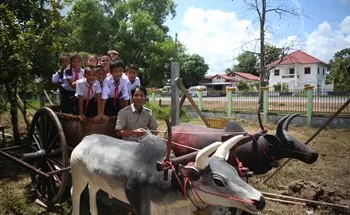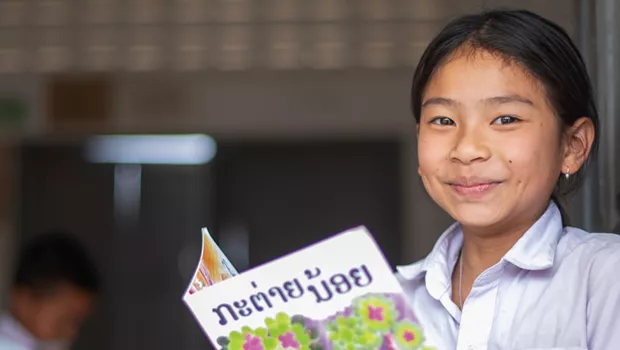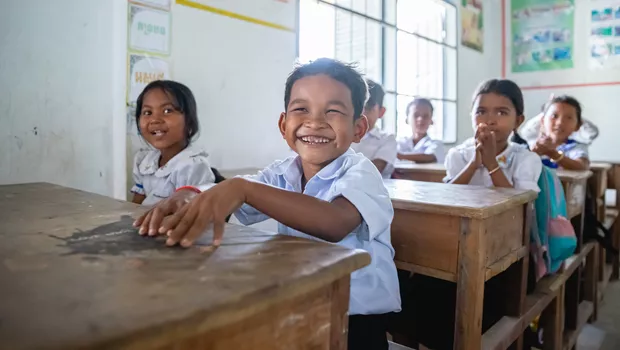Born and raised in Laos’s Champasak province, Principal Amphone Onxaivieng has seen many sides of local education. Having studied at the very school he now oversees, the 49-year-old also knows what it’s like to grow up yearning for educational resources.
“When I was growing up, education was very different from today. There were no text books, instruction for teachers, teaching materials, or story books. We also had limited school buildings and classrooms. Even though the school was not far, I struggled with these challenges, didn’t study well and repeated a grade.”
He's since turned this experience into personal motivation to ensure every student at Nonghaikhok Complete Primary School has what they need to succeed.

Planting Seeds for the Future
An educator with 29 years of experience, Amphone’s duties extend far beyond the average principal. His standard week ranges from overseeing administrative duties to running the school’s community garden and garnering parental involvement. Regardless of what task he’s involved in, each has an overarching theme – to leave the community in a better place than they found it.
“I’m really passionate about doing something different in my community. I lead teachers and students to do meaningful things like growing organic crops, planting trees, decorating and cleaning at school,” says the principal.
Since creating the community garden, this popular activity, gives students the chance to reap what they sow. The produce is later sold at the market and used to fund school activities and materials, showing students the tangible change that comes with community effort.
Education as a Bridge Between Languages
But this principal knows most student struggles stretch far beyond the garden. As one of the world’s least-developed countries, most Lao families live on less than $2 a day. Laos is also incredibly diverse with 220 languages spoken by 7 million people. As a result, 47 percent of the children don’t speak Lao at home, yet Lao is the only official language of instruction in schools. This sensitive issue poses an added barrier for almost half of the country’s children. Between tight finances and lingual hurdles, quality education often sits on the back-burner.
“The common struggle students face in the community is that many parents are not aware of the value of education and do not support their children to go to school. For example, some of the school girls were often absent, because their families needed help with household chores and take care of younger siblings while their parents work the fields," he says.
Amphone remedies this by hosting parent community workshops through Room to Read. These efforts have proven successful for a range of villagers, including Mrs. Phoukhan Satkoun, a local mother who initially kept her daughter home for household help, but with Amphone’s encouragement brought her daughter back to school to study again.

 Great Things to Come
Great Things to Come
For the Champasak native, these little victories add up to bright beams of hope. With the help of Room to Read’s Literacy Program, Amphone has seen growth in both students and teachers. He’s witnessed progress in students like first grader, Namneung, who can now read and write in Lao on her own.
“Sometimes Namneung can read as fluently as Grade 3 students,” said Amphone.
Full of enthusiasm, he believes this is just the start of great things to come. And judging by the progress of Laos’s Literacy Program, he’s right.
A recent two-year evaluation revealed that children benefiting from the Lao Literacy Program made nearly three times more progress in reading fluency than their peers in comparison schools. By the end of Grade 2, children from Literacy Program schools could correctly read an average of 39 words per minute, while children from comparison schools could correctly read only 14.
Committed to bridging the language barrier, Room to Read started piloting an Oral Language Intervention as part of the Literacy program in 20 schools in non-Lao speaking communities in Champasak province with plans to continue expanding until 2020.
Yet, these monumental moves couldn’t happen without Amphone. With the help of change-makers like him, Room to Read pairs its long-term planning with growing community support, creating a ripple of systematic change.
“I am motivated to keep improving this school and community, because this is my hometown. I’m passionate about serving here. I have a dream to see better change. I want this school to become a good model for other schools in the district.”
You can help more educators like Amphone create lasting change in their community by supporting Room to Read’s work in Laos.
Invest in children's education today.



